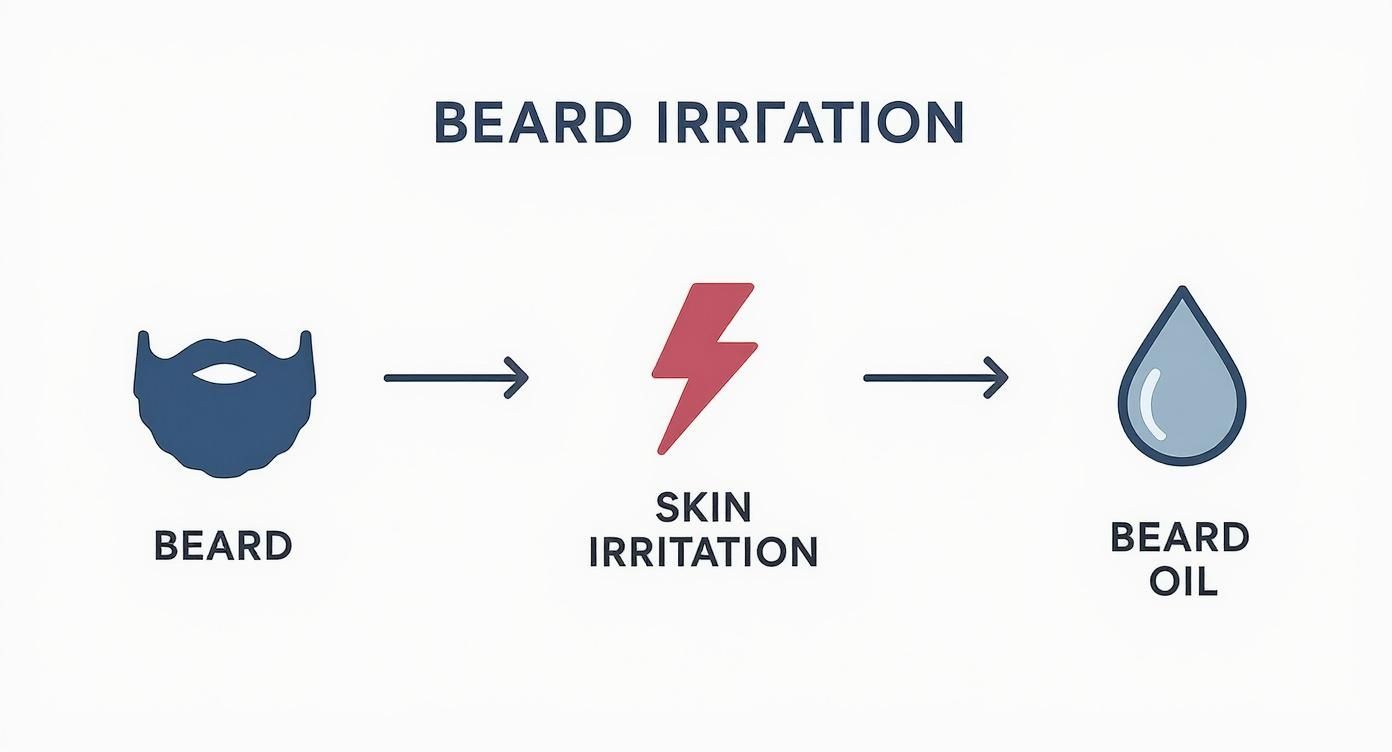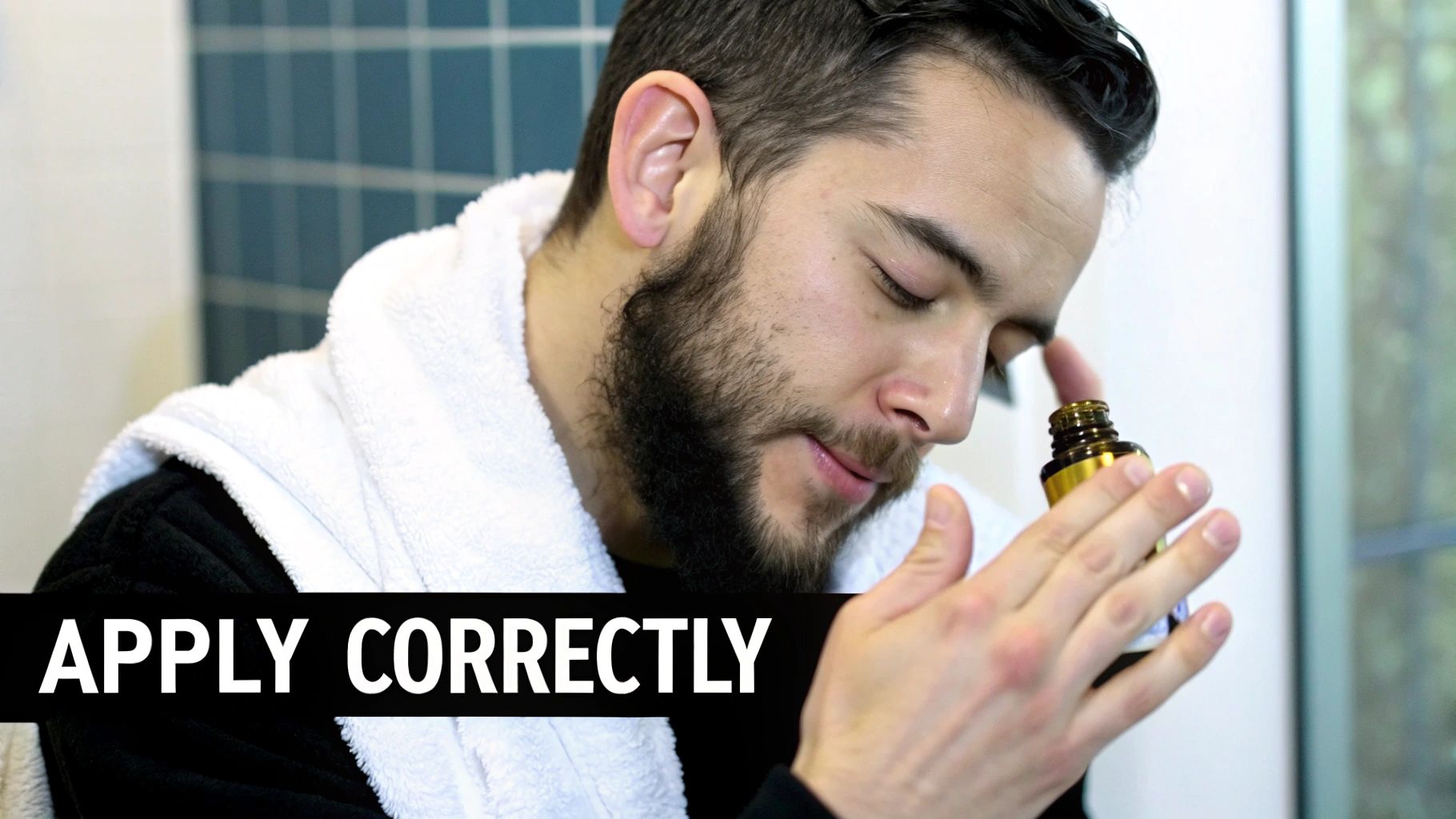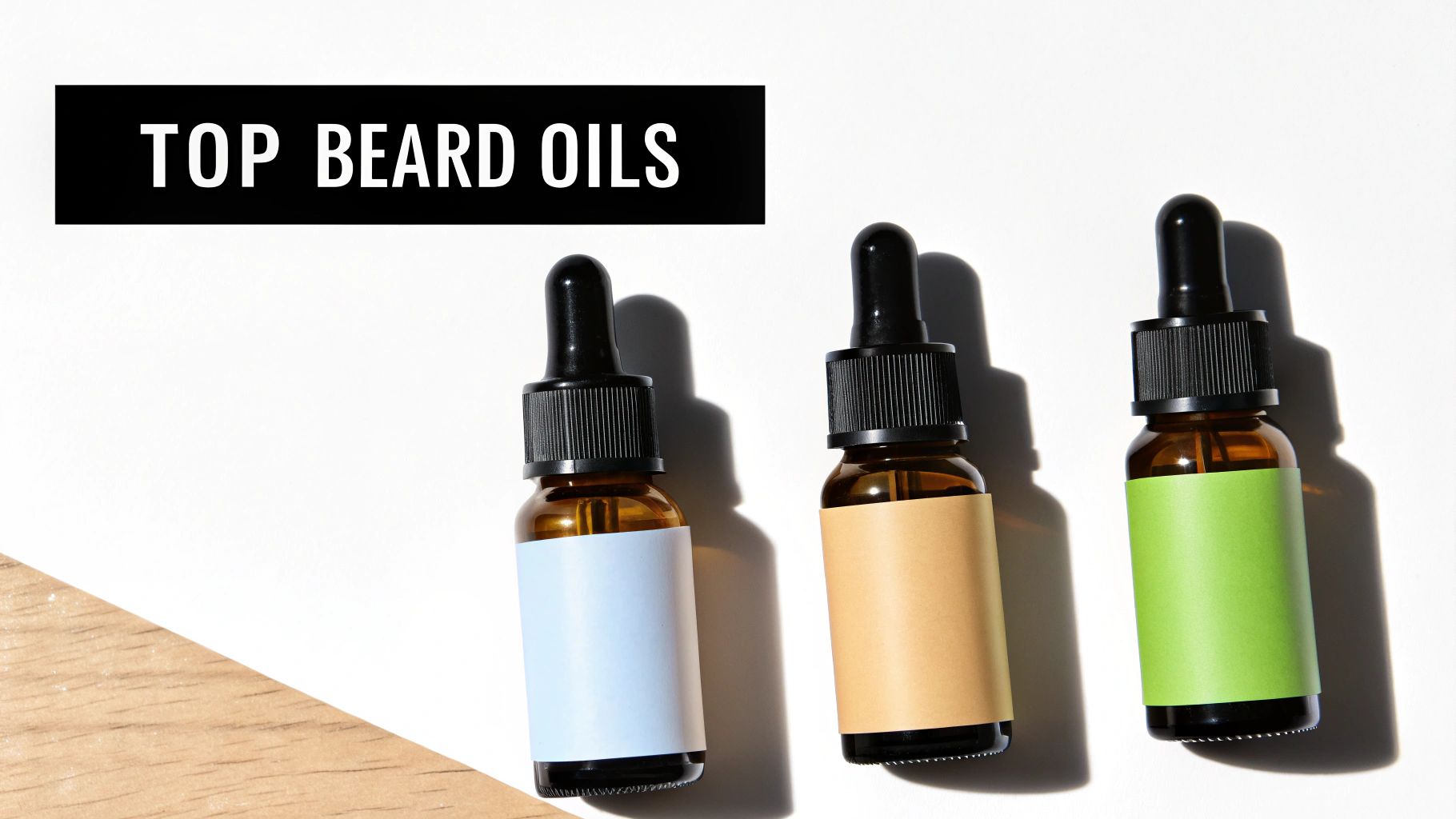Jan Elvis
02.11.2025

Jan Elvis
02.11.2025
When you have sensitive skin, finding the right beard oil isn't just about softening your whiskers—it's about finding peace for your face. The best choice will always be a fragrance-free, hypoallergenic formula. Look for products built around gentle, non-comedogenic carrier oils like jojoba, argan, or grapeseed oil. These ingredients are fantastic because they closely mimic your skin's natural sebum, offering a dose of hydration and soothing relief without clogging pores or triggering a reaction.
If growing a beard has felt less like a style choice and more like a constant struggle with redness, itchiness, and flakes, trust me, you're in good company. The problem usually isn't the beard itself but the micro-environment it creates on your skin.
Think of it this way: your facial skin is the soil, and your beard is the garden. You can't expect healthy growth if the soil is irritated, dry, and depleted.
Several things can throw that delicate ecosystem off balance. For one, your beard hair acts like a wick, pulling your skin's natural, protective oils away from the surface. This leaves the skin underneath parched and defenseless, often leading to the dreaded "beardruff"—which is really just dry, flaky skin making a run for it.
On top of that, your beard is a master at trapping potential irritants right up against your skin. The usual suspects include:
The real issue is that your beard fundamentally changes your skin's ecosystem. A good beard oil designed for sensitive skin does more than just soften the hair; it works to restore balance to the skin underneath, giving it the nourishment it needs to calm down and thrive.
So, what really separates a beard oil made for sensitive skin from a standard one you'd grab off any shelf? Let's break it down. The differences lie in the core philosophy: one is about conditioning hair, while the other is about caring for the skin first and foremost.
| Feature | Standard Beard Oil | Beard Oil for Sensitive Skin |
|---|---|---|
| Fragrance | Often contains synthetic fragrances or potent essential oils for scent. | Typically fragrance-free or uses minimal, non-irritating essential oils. |
| Carrier Oils | May use heavier oils that can clog pores (comedogenic). | Prioritizes lightweight, non-comedogenic oils like jojoba, argan, or grapeseed. |
| Key Additives | Focuses on shine and scent-enhancing ingredients. | Includes soothing, anti-inflammatory ingredients like Vitamin E or chamomile. |
| Primary Goal | Soften beard hair and add a pleasant scent. | Soothe skin, reduce irritation, and hydrate both skin and hair. |
Ultimately, choosing a beard oil for sensitive skin is about picking a product formulated with a skin-first approach. It's designed to calm, not just to coat.
This is where being selective about your products makes all the difference. In fact, studies show that over 40% of men with beards experience skin irritation from their grooming products, which is exactly why so many brands are now developing gentler options.
Manufacturers have started focusing on formulas rich in anti-inflammatory and deeply moisturizing ingredients. Things like argan oil, grapeseed oil, and vitamin E have been shown to reduce irritation by up to 60% when compared to conventional beard oils. You can dig into the data yourself by checking out the latest beard oil market growth and trends.
A specialized beard oil acts as a double-duty product: it’s a conditioner for your beard and a healing serum for your skin, delivering targeted relief right where you need it most.
Trying to read the ingredient list on a beard oil bottle can feel like deciphering a secret code. But it’s the single most important skill you can develop to find the best beard oil for sensitive skin. Forget the marketing buzzwords on the front; the real story is always on the back.
Think of a top-tier beard oil not just as a single product, but as a team of specialists. Each ingredient has a specific job, and when you've got sensitive skin, you need the A-team—the ones that calm, protect, and heal. Once you learn to spot them, that confusing label becomes your roadmap to relief.
The whole process is pretty straightforward, but it's easy to get stuck in a cycle of irritation if you don't know what you're looking for.

As you can see, the right oil is the crucial step that breaks the itch-and-scratch cycle and lets you enjoy your beard without the constant discomfort.
Let's start with the foundation of any good beard oil: the carrier oils. I call these "The Calmers" because their main job is to moisturize and soothe without making a fuss.
Both of these are non-comedogenic, which is just a fancy way of saying they won’t clog your pores. That’s non-negotiable when you’re trying to prevent beard-related breakouts. For more on what makes an oil truly high-quality, check out our deep dive into what is good beard oil.
Next up, you need a "Repair Crew." These are the ingredients that go beyond simple moisturizing to actively heal and reinforce your skin’s protective barrier, which often takes a beating when it's sensitive.
Think of your skin's barrier like a brick wall. A healthy barrier keeps moisture locked in and irritants locked out. When it's compromised, you get cracks in the mortar. Ingredients like Vitamin E are that fresh mortar, sealing up the gaps and making the wall strong again.
Here are the key players you want on this team:
Finally, every good formula needs "The Guardians." These are ingredients that create a light, breathable shield to protect your skin from daily grime, dust, and pollution without feeling greasy. Grapeseed oil is a perfect example; it's incredibly light, absorbs in a flash, and leaves nothing behind but a subtle protective layer.
This focus on gentle, hard-working ingredients isn't just a niche trend. We're seeing a major shift in the market, with over 35% of men now actively looking for beard oils made for sensitive skin or labeled fragrance-free. Brands are listening, ditching the harsh synthetics and prioritizing soothing botanicals to meet the demand. You can see more on these trends in the beard oil market.
https://www.youtube.com/embed/_llvXPvDGb8
Knowing what to look for is only half the battle. To really keep your skin happy, you need to get good at spotting the common troublemakers on an ingredients list. Finding the right beard oil for sensitive skin is often a process of elimination, and these are the first things you’ll want to cross off your list.
Think of yourself as a bouncer for your own face—your job is to keep the known agitators out. Certain ingredients are notorious for causing redness, itching, and breakouts, turning your magnificent beard into a daily source of frustration. Learning to spot them is the quickest way to dodge a bad purchase and an even worse skin reaction.
By far, the biggest offender is synthetic fragrance. You’ll see it listed simply as "fragrance" or "parfum" on the label, a sneaky term that can legally hide hundreds of undisclosed, often irritating chemicals. For anyone with sensitive skin, it’s like playing Russian roulette with your face.
Even natural essential oils can be a problem if they're too concentrated. While oils like peppermint or tea tree oil sound great, their potency can easily overwhelm reactive skin, leading to that all-too-familiar stinging and redness. A good beard oil for sensitive skin will either be completely unscented or use a tiny amount of calming essential oils, like chamomile or frankincense.
It's interesting how you can apply lessons from other areas here. For example, understanding the principles of pet-safe products—which focus on simple, fragrance-free, and non-irritating formulas—gives you a great framework for choosing your own skincare.
Not all alcohols are bad, but you definitely need to watch out for the drying kind. Simple alcohols like SD alcohol, denatured alcohol, or isopropyl alcohol are often used to make a product feel lighter, but they do so by stripping your skin of its natural moisture barrier. This kicks off a nasty cycle of dryness and irritation, which can cause your skin to overproduce oil and lead to breakouts.
An ingredient label should read like a recipe for calmness. If you see drying alcohols, heavy silicones, or vague "fragrance," it's a clear sign the product wasn't formulated with your skin's well-being in mind.
Finally, keep an eye out for heavy silicones. These are ingredients that usually end in "-cone," like dimethicone. They work by creating a synthetic film over your skin and hair, which feels smooth at first but can also trap sweat, dirt, and bacteria. For sensitive skin, this is a recipe for clogged pores and irritation. It's much better to stick with natural, breathable oils that actually nourish your skin instead of just coating it.
Having the best beard oil for sensitive skin is half the battle, but the real magic is in how you use it. If you just slick it over your beard hair, you're missing the point. The goal is to get those soothing ingredients right down to the skin underneath, which is where the itchiness, flakes, and irritation actually start.

Think about it like watering a plant. You don't just spritz the leaves and call it a day, right? You water the soil to feed the roots. It's the exact same idea here. You need to nourish the skin to get a healthy, comfortable beard.
Timing is everything. The absolute best time to put on beard oil is right after a warm shower. The steam opens up your pores and softens the hair follicles, making your skin a perfect sponge for all that goodness.
After your shower, gently pat your beard with a towel so it's still slightly damp, not soaking wet or bone-dry. That little bit of leftover moisture helps the oil spread evenly and seals in hydration. Trying to apply oil to a completely dry beard just doesn't work as well and can leave you feeling greasy.
Consistency is your best defense against irritation. Making this a daily morning ritual does more than just soothe current problems. It builds a protective barrier on your skin that wards off flare-ups all day long. It’s a simple, foundational step for both beard and skin health.
Nailing the technique means you get all the benefits without wasting a single drop. With a good, concentrated oil, a little bit truly goes a long way.
Alright, we’ve covered a lot of the science behind what makes a good beard oil for sensitive skin. Now, let's put that knowledge to work and look at some products that actually get it right. I've gone through the noise to find the formulas that truly deliver.
Think of this not just as a list, but as a practical guide. Each pick highlights the gentle "Calmers" and "Repair Crew" ingredients we talked about, and you won't find any of those harsh irritants on their labels. These are the top contenders for getting you that comfortable, healthy, and great-looking beard you're after.

First up is a fantastic example of a minimalist, "less is more" approach. It’s built on a beautifully simple base of jojoba and argan oil, making it a poster child for leveraging "The Calmers." This blend mimics your skin's own oils almost perfectly, which means it soaks in quickly and gets to work without leaving you feeling greasy.
This oil is proof that you don't need a laundry list of ingredients for incredible results. Its simplicity is its genius.
Our next pick brings in "The Repair Crew" to take things up a notch. While it still uses gentle carriers like grapeseed and jojoba, it’s supercharged with botanical extracts famous for their anti-inflammatory muscle. We're talking about ingredients like chamomile and aloe vera that actively dial down redness and soothe irritation.
This one strikes the perfect balance. It goes beyond basic hydration by using active botanicals to fight inflammation directly. It's a great choice for skin that's always a little red or easily agitated.
It's completely free of synthetic fragrances, getting a faint, earthy aroma from its natural ingredients. The feel is silky smooth, and it keeps your beard and skin moisturized all day long.
If you're dealing with seriously dry, flaky skin under your beard, this one is your heavy hitter. It's a deeply conditioning blend that leans on slightly richer oils, like avocado and sweet almond oil, to deliver a major dose of moisture and fatty acids. This helps rebuild your skin's natural barrier and lock in hydration.
This formula really shows how the right mix of nutrient-dense oils can tackle severe dryness without ever feeling heavy or clogging pores. It also includes a touch of frankincense essential oil, known for its skin-healing properties, but it's subtle enough not to cause a problem.
The demand for these kinds of specialized formulas is exploding. The whole beard care market is expected to rocket past $4 billion by 2025, and a huge part of that growth is brands investing in hypoallergenic products. Online shops have seen a 25% year-over-year jump in searches for 'beard oil for sensitive skin,' which tells you just how many of us are looking for real solutions. For a deeper dive, check out these beard care market trends and analysis.
Figuring out beard care when you have sensitive skin can feel like walking through a minefield. You've learned what ingredients to look for and which ones to run from, but there are always those specific questions that pop up. Let's clear the air and tackle those common concerns head-on so you can move forward with confidence.
Think of this as your quick-reference guide for all those lingering "what ifs." Getting these details right is the key to locking in a solid routine and getting the best results from your beard oil.
It’s tempting, I get it. You see a jar of coconut oil in the kitchen and think, "Why not?" But for your face, this is not the best move. Coconut oil is highly comedogenic, which is just a fancy way of saying it's extremely likely to clog your pores. For the already-sensitive skin under your beard, that’s a recipe for breakouts and irritation.
This is exactly why beard oils are formulated with non-comedogenic oils like jojoba or argan. They’re designed to hydrate your skin and hair deeply without suffocating your pores, making them a much safer and more effective choice.
You should feel a difference almost right away. A good beard oil will offer instant relief from that maddening itch and a noticeable softness in your beard after just the first couple of uses.
That said, for the more stubborn issues like visible redness or flaky skin, you'll need to be a little more patient.
Expect to see real improvements in your skin's health and a big drop in redness within 1-2 weeks of consistent daily use. This gives your skin’s moisture barrier time to repair itself and lets the soothing ingredients get to work. Consistency is the name of the game here.
If that redness is still hanging around after a couple of weeks, it might be time to look at some other calming strategies. Our guide on how to get rid of redness has some extra tips that work great alongside your beard care routine.
This is a huge one, and it trips a lot of people up. These two terms are absolutely not the same, and for anyone with sensitive skin, knowing the difference is crucial.
To play it safe, always, always choose products clearly labeled "fragrance-free."
Yes. One hundred percent, yes. A patch test is your non-negotiable safety net before slathering any new product on your face. It's a simple step that can save you from a world of hurt.
Just apply a single drop of the new oil to a hidden spot, like the skin behind your ear or on your inner wrist. Then, wait a full 24 hours. If you don't see any redness, feel any itching, or notice any irritation, you're good to go.
Ready to end the search for the perfect beard oil? The Main Character Beard Oil is specifically formulated to be gentle, effective, and completely fragrance-free, giving your sensitive skin the calm it deserves. Experience the difference and get yours today at https://www.dontlooktrash.com.